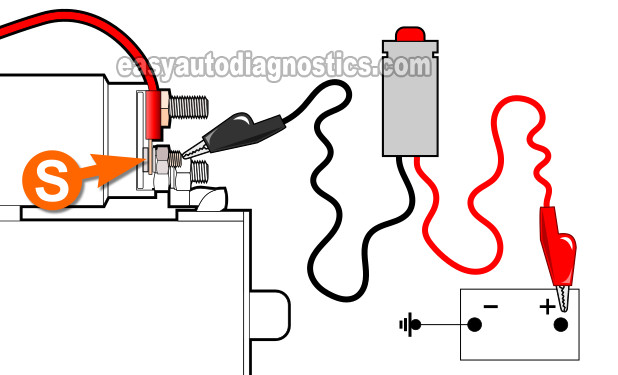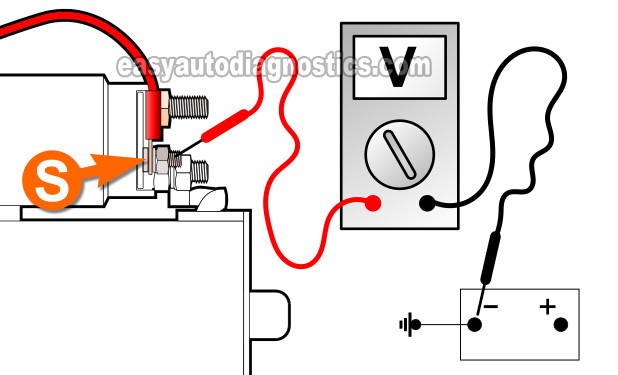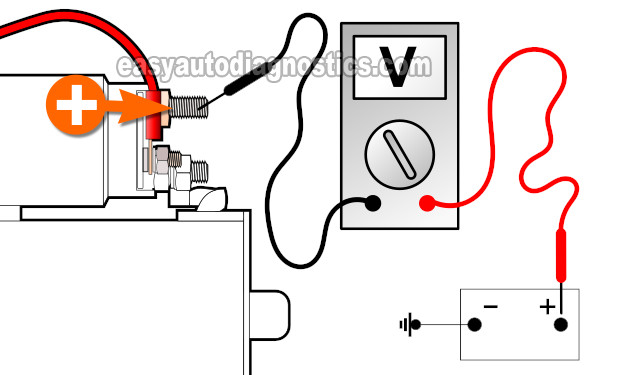
You can easily test the starter motor with a few simple tools. In this tutorial, I'll share my starter motor testing method.
You'll quickly find out if the starter motor is bad and causing a no-crank condition.
NOTE: You'll notice that the photos I'm using are of the starter motor off of the vehicle. I've done this to make it easier to show you where to make your test connections. You don't need to remove the starter motor from your 4.0L Ford Ranger (Mazda B4000) to follow the test instructions in this tutorial.
Ford Explorer: You can find the 4.0L Ford Ranger (Aerostar, Mercury Mountaineer) starter motor test tutorial here:
- How To Test The Starter Motor (4.0L Ford Explorer, Aerostar, And Mercury Mountaineer) (at: troubleshootmyvehicle.com).
Contents of this tutorial:
![]() You can find this tutorial in Spanish here: Cómo Probar El Motor De Arranque (4.0L Ford) (at: autotecnico-online.com).
You can find this tutorial in Spanish here: Cómo Probar El Motor De Arranque (4.0L Ford) (at: autotecnico-online.com).
APPLIES TO: This tutorial applies to the following vehicles:
- 4.0L V6 Ford Ranger: 1990, 1991, 1992, 1993, 1994, 1995, 1996, 1997, 1998, 1999, 2000, 2001, 2002, 2003, 2004, 2005, 2006, 2007, 2008, 2009.
- 4.0L V6 Mazda B4000: 1994, 1995, 1996, 1997, 1998, 1999, 2000, 2001, 2002, 2003, 2004.
Important Testing Tips
The following testing tips will help you test the starter motor without complications:
TIP 1: The battery must have a full charge before starting any of the tests in this tutorial.
TIP 2: The battery cable terminals and the battery posts should be clean and corrosion-free before starting the tests.
TIP 3: Read the entire article first to familiarize yourself with the tests.
TIP 4: Use jack stands for safety. Don't trust the jack alone to keep your vehicle up in the air while you're underneath it!
TIP 5: Take all necessary safety precautions. Use safety glasses while working underneath the vehicle. Be alert and think safety all of the time.
Symptoms Of A Bad Starter Motor
When the starter motor fails completely, the engine will not turn over when you turn the key to start it.
The starter motor can also fail intermittently. When this happens, the starter motor functions most of the time, but now and then, it doesn't.
You'll notice that the common thread between these types of failures is that the engine will not turn over when you turn the key to start it.
Tools Needed To Test The Starter Motor
Disclosure: As an Amazon Associate, I earn from qualifying purchases. Buying through these links helps support this site at no extra cost to you. Thanks for your support —it really means a lot!
The cool thing about testing the starter motor is that you don't need expensive or exotic testing equipment to do it.
The tools you'll need won't break the bank. Here's a list of what you'll need:
- Jack.
- You'll need to raise your vehicle to gain access to the starter motor.
- Jack stands.
- A remote starter switch.
- If you'd like to see what a remote starter switch looks like, you can follow this link: Innova 3630 Remote Starter Switch (Amazon affiliate link).
- You can either buy this tool online or you can buy it at your local auto parts store (AutoZone or O'Reilly Auto Parts, etc.).
- A multimeter or a 12 Volt automotive test light.
- If you don't have a multimeter or need to upgrade yours, check out my recommendation here: Tekpower TP8268 AC/DC Auto/Manual Range Digital Multimeter (Amazon affiliate link).
- A wire piercing probe.
- This tool is not an 'absolute must-have tool' but I can tell you from experience that it makes it a whole lot easier to probe the 'S' terminal wire for the Start Signal.
- If you'd like to see what this tool looks like, you find out more about it here: Wire Piercing Probe Tool Review (Power Probe PWPPPPP01).
- A helper.
TEST 1: Applying 12 Volts To The 'S' terminal

Your first test is to apply 12 Volts to the starter motor solenoid's 'S' terminal.
If the starter motor comes to life and cranks the engine, then you can conclude right off the bat that the starter motor itself is not the cause of your engine's no crank problem. Your next step is to go to TEST 2.
If the starter motor does not crank the engine, then you can generally conclude that the starter motor is bad.
IMPORTANT: Remove the key from the ignition switch for this test.
OK, let's get testing:
- 1
Raise your Ford Ranger (Mazda B4000) and place on it jack stands. Remember, the only way to gain access to the starter motor is from underneath the vehicle.
- 2
Disconnect the battery negative (-) terminal.
You'll reconnect it back in one of the following steps, for now, it's a safety precaution as you set up the test. - 3
Attach one end of the remote starter switch to the battery positive (+) post.
- 4
Attach the other end of the remote starter switch to the 'S' terminal of the starter motor solenoid.
This is easier said than done, so take your time and make sure the connection is on the 'S' terminal of the starter motor solenoid.
Also, in case you're wondering, you can leave the starter motor solenoid's 'S' terminal wire connected to the engine's wiring harness connector or not, the test will work either way. - 5
Reconnect the battery negative (-) cable to the battery negative (-) post.
- 6
Apply 12 Volts to the 'S' terminal wire of the starter motor starter solenoid with your remote starter switch.
- 7
You'll get one of two results:
1.) The starter will activate and will turn over the engine.
2.) The starter motor won't do a thing.
Let's take a look at what your test results mean:
CASE 1: The starter motor cranked the engine. This is the correct and expected test result.
You can conclude that the starter motor itself is OK. The next step is to see if the starter motor is getting the 12 Volt Start signal on the 'S' terminal wire. Go to: TEST 2: Verifying The 12 Volt Start Signal.
CASE 2: The starter motor DID NOT crank the engine. This usually means that your starter motor is bad and needs to be rebuilt or replaced.
I suggest you perform two more tests. First, make sure the starter motor is getting its 12 Volt Start signal. Second, voltage drop test the battery cable (that attaches to the starter motor solenoid).
- Go to: TEST 2: Verifying The 12 Volt Start Signal.
- Go to: TEST 3: Voltage Drop Testing The Battery (+) Cable.
TEST 2: Verifying The 12 Volt Start Signal

If you've reached this point, the starter motor did activate when you applied 12 Volts to the starter motor solenoid's 'S' terminal (TEST 1).
But if the starter motor is not cranking the engine on its own, then there's a good chance that it's not receiving the Start signal.
So in this test section, you'll check the 'S' terminal wire for the presence of the Start signal when your helper turns the key to crank the engine.
Let's get testing:
- 1
Raise and place the front vehicle on jack stands (if it isn't already).
- 2
Grab and set your multimeter on Volts DC mode.
- 3
Ground the black multimeter test lead directly on the negative battery terminal using a jump start cable.
You can also Ground it on the engine, if you can find a clean, unpainted and rust-free spot of metal. - 4
Connect the red multimeter test lead to the 'S' terminal wire using an appropriate tool.
Don't know which wire is the 'S' terminal wire? This is the one that connects to the smaller of the three studs on the starter motor solenoid.
The 'S' terminal wire (circuit) is the one that delivers the Start (Crank) signal from the ignition switch. - 5
Have your helper turn the key to crank the engine when the test is setup.
- 6
Your multimeter should read 10 to 12 Volts DC.
OK, let's interpret your test results:
CASE 1: Your multimeter registered 10 to 12 Volts. This is the correct and expected test result and it confirms that the starter motor is receiving its activation signal.
Now, in the majority of the cases, you could stop testing here and replace the starter motor and be done. But, I suggest one more test so that you can be absolutely sure there isn't another issue to deal with.
Your next test is to voltage drop test the battery positive (+) cable. This is a very easy and simple test to do. Go to: TEST 3: Voltage Drop Testing The Battery (+) Cable.
CASE 2: Your multimeter DID NOT register 10 to 12 Volts. This test result lets you know that the starter motor isn't receiving an activation signal.
Although finding out why this activation signal is missing is beyond the scope of this tutorial, the most likely causes are:
- A bad starter motor relay.
- A bad park-neutral safety switch.
- A bad clutch pedal switch.
- A bad ignition switch.
TEST 3: Voltage Drop Testing The Battery (+) Cable

The starter motor receives the battery's voltage and amperage through a single wire.
In this test section you'll make sure that this battery wire is delivering all of the battery's output.
To be a bit more specific, you'll do a voltage drop test on the wire to make sure that it's delivering the battery's maximum output without any obstructions.
This is what you need to do:
- 1
Place your multimeter in Volts DC mode.
- 2
Attach the red multimeter test lead to the positive (+) battery post. The positive (+) battery post must be clean and corrosion-free.
You may need two helpers for this test step, since someone will have to hold the red multimeter test lead onto the battery positive (+) terminal bolt and someone else inside the vehicle (to crank it when everything is set up). - 3
Place the black multimeter test lead on the starter motor solenoid stud that connects to the battery positive (+) cable (see illustration above).
The orange arrow with the plus (+) sign, in the illustration above, points to this stud.
Maintain the black multimeter test lead in this position throughout the next step. - 4
When everything is ready, have your helper turn the key to crank the engine.
Although the starter motor won't crank the engine, your helper has to turn the ignition switch to start the engine for the voltage drop test to work. - 5
The multimeter should register 0.5 Volts or less (0.5 V = 0 Volts).
If there's a problem in the wire, your multimeter will register some voltage, usually 5 Volts or more.
Let's take a look at what your results mean:
CASE 1: Your multimeter indicated NO voltage drop (which is 0.5 Volts or less). This result indicates the starter motor is receiving all of the battery voltage and amperage it needs to crank the engine.
You can conclude that the starter motor is bad and needs replacement if you have:
- Confirmed that the starter motor does not crank the engine (TEST 1).
- Confirmed that the starter motor is receiving an activation signal (TEST 2).
- Confirmed, in this test section, that the battery positive (+) cable does not have a voltage drop issue.
Now, before you remove the starter motor, do one more important thing:
- Turn the engine manually (using a 1/2 ratchet and the appropriate socket on the crankshaft pulley bolt). This will check to see if the engine is mechanically locked up (or not).
If you'd like to bench test the starter motor (after removing it). You can find the step-by-step instructions here:
CASE 2: Your multimeter registered 5 Volts or more. This result tells you that a voltage drop does exist in the wire (and it's not a good thing).
This voltage drop will prevent the battery's total amperage output from reaching the starter motor.
You'll need to thoroughly clean both ends of the battery positive (+) cable to solve this problem.
Cleaning the end that attaches to the starter motor solenoid should be done with a small piece of sandpaper. Once both ends of the battery positive cable are clean, reconnect everything and try cranking the engine. If the voltage drop was the cause of the no-crank condition, the starter motor will now crank the engine.
More 4.0L V6 Ford Ranger (Mazda B4000) Tutorials
You can find a complete list of 4.0L V6 Ford Ranger (Mazda B4000) tutorials in this index:
Here's a small sample of the tutorials you'll find in the index:
- Fuel Pressure Specifications (1991-2011 4.0L Ford Ranger And Mazda B4000).
- How To Test Engine Compression (1991-2011 4.0L Ford Ranger And Mazda B4000).
- How To Test For A Blown Head Gasket (1991-2011 4.0L Ford Ranger And Mazda B4000).

If this info saved the day, buy me a beer!



